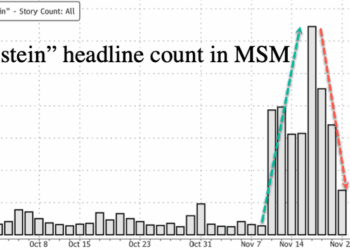
President Donald Trump has made little secret of his desire to reshape America’s institutions of higher education, viewing them as entrenched factories of progressive indoctrination. His administration has frozen research funding, launched civil rights investigations, and publicly pressured university leaders. Its newest tactic is more of a carrot-and-stick approach: offering first crack at research funding in exchange for instituting sweeping reforms.
On October 1, the Trump administration sent letters to nine prominent universities inviting them to sign onto the “Compact for Academic Excellence in Higher Education” to receive “substantial and meaningful federal grants, and other federal partnerships.” In return, universities would agree to follow new guidelines on admissions, academic freedom, and free speech; curb grade inflation; freeze tuition; and more.
The compact’s nine recipients include six private universities—Brown University, Dartmouth College, the Massachusetts Institute of Technology, the University of Pennsylvania, the University of Southern California, and Vanderbilt—and three public institutions—the University of Arizona, the University of Texas, and the University of Virginia. But the White House wants the compact to be “agreed to by a wide range of excellent universities”—so last week’s rollout is likely just the start. The letters ask the schools to submit comments on the compact by October 20, with a target of having signed agreements by November 21.
University responses to the compact have been limited—and noncommittal—so far. The chairman of the University of Texas System’s Board of Regents offered a positive-sounding statement while Dartmouth’s president said, “[W]e will never compromise our academic freedom and our ability to govern ourselves.” California Gov. Gavin Newsom weighed in, threatening to cut funding to any California school that signs onto the pact, while the interim president of USC, which as a private school does not receive the bulk of its funding from the state, said the proposal “covers a number of issues that I believe are important to study and discuss.” The reaction from mainstream academia has been predictably negative.
The compact raises a number of concerns, including constitutional questions about separation of powers, federal impingement upon state powers, infringement on academic freedom, and the durability of the agreement beyond the current administration. I will leave those important issues aside for now, because in the din of criticism and commentary, there has been little close analysis of the compact’s provisions, so here’s a breakdown.
Nondiscrimination in admissions, and more.
Neutrality and nondiscrimination are a major theme of the compact, encompassing hiring, discipline, and admissions.. Signatories commit to not discriminate in hiring in ways already prohibited by Title VII of the Civil Rights Act. The compact also forbids discrimination in programming and discipline on the basis of “membership in a racial, ethnic, national, or religious group, or based on sex, sexual orientation, or gender identity.” This also wouldn’t involve much change, though the enforcement provisions could dramatically increase the cost of noncompliance. The compact commits schools to interpret the terms male and female “according to reproductive function and biological processes,” a point that reflects current Title IX regulations and was conceded by Penn to resolve a Title IX violation.
By contrast, the compact would transform the practice of admissions. Under the compact, admissions would rely on published, “objective criteria” and applicants would be required to submit standardized test scores. (As currently drafted, the compact doesn’t require schools to consider those test scores, one of many drafting tics that will presumably be cleaned up in the final version.) Currently, most schools run admissions as a “holistic” process with many—often very subjective— inputs. In the case of USC, applicants are asked to explain what their life’s theme song would be, but submitting an SAT score is optional. This type of practice is almost universal among elite schools, resulting in a system that can yield absurd results‚ as I have laid out in detail elsewhere.
Under the compact, schools would not consider “sex, ethnicity, race, nationality, political views, sexual orientation, gender identity, [or] religious associations” in admissions or financial aid. Relatedly, they would publish GPA and test score ranges for admitted students broken down by race, national origin, and sex.
Some of this is old and some is new. Consideration of race in admissions is already illegal. So is consideration of sex for all vocational and graduate schools, as well as for all public universities. But it is legal and relatively common at private undergraduate colleges, since women outnumber men and schools want gender balance. Private schools would no longer be able to seek such a balance if they signed the compact. The compact also commits signatories not to consider gender identity or sexual orientation in admissions, even though the treatment of those concepts under Title IX is very much contested.
The compact also bars consideration of religion and political views, which is new. Here again, the point is to focus only on objective measures of academic achievement and end the holistic approach. The compact does not forbid universities giving advantages to legacies, athletes, or students with certain talents—so it appears those practices could continue.
At the top 100 or so colleges, this system would be a radical change, and it would lead to far more predictable outcomes for applicants. But admissions at most U.S. colleges are not competitive enough for any of this to matter; these schools accept every qualified applicant without the luxury of considering what their life’s theme song would be.
Institutional neutrality and academic freedom.
The compact requires signatories to affirm “institutional neutrality at all levels of the administration” and to adopt a policy “addressing academic freedom.” These ideas are well-established in higher education, and many prominent schools (including most of the nine recipients of the compact) have formally adopted one or both ideas. That said, two schools with identical policies are likely to enforce them in very different ways. Here again, this provision of the compact may not change the rules much, but it could increase the risk of compliance failures.
Institutional neutrality is the idea that universities should not take positions on social or political issues unless they directly affect the university. Originating at the University of Chicago in 1967, the classic statement of neutrality says, “The university is the home and sponsor of critics; it is not itself the critic.” Seven of the schools being offered the compact have formally adopted institutional neutrality; MIT and Arizona have not.
The compact also requires signatories to adopt academic freedom policies, though it does not specify what kind. The Chicago Principles are a common benchmark for academic freedom , and they have been adopted or endorsed by five of the nine schools invited to join the compact: Arizona, MIT, Vanderbilt, Texas, and Virginia. The other four have academic freedom policies of some kind, usually leaving more latitude to curtail speech under certain conditions. Like institutional neutrality, academic freedom can be complicated in practice, as the University of Texas’ experience shows. Texas adopted a version of the Chicago Principles, but new state laws aimed at limiting disruptive protests may violate those principles and possibly the First Amendment. Even the compact concedes that academic freedom is not absolute, and university policies should “prevent discriminatory, threatening, harassing or other behaviors” that abridge others’ rights. The Chicago Principles also make that point.
‘A broad spectrum of ideological viewpoints.’
The compact commits signatories to foster “a broad spectrum of ideological viewpoints,” which may require “transforming or abolishing” units that “punish, belittle, and even spark violence against conservative ideas.” This is surely its most controversial provision, and it sits uneasily alongside the principles of institutional neutrality and academic freedom. Many conservatives view the present university environment as so hostile to mainstream views that the system needs to be rebalanced. To be sure, if academic departments speak out on public issues in violation of the neutrality principle, the university can take action. But if individual academics within a department all have the same social or political views, principles of academic freedom will protect them. The compact appears to anticipate this issue with its reference to “abolishing units”—something that can potentially be carried out within the power of a governing board, though a move of this kind that is clearly premised on ideological factors would violate academic freedom and certainly prompt lawsuits.
Ideological balance is hard to engineer, since birds of a feather will find a way to flock together. Yet the compact commits signatories to developing viewpoint diversity in “every field, department, school, and teaching unit.” Even if this was a consensus goal, the practical challenges are daunting. The University of Arizona, for example, has 100 departments in 20 colleges. Monitoring and managing its ideological makeup would be like trying to nail 100 pieces of Jell-O to the wall.
Grade inflation.
The compact attempts to re-set the ratchet of grade inflation by committing its signatories to award grades that “rigorously reflect the demonstrated mastery of a subject.” This is a subjective standard aimed at a near-universal problem. A few institutions like Reed College have bucked the trend, but at many schools the most commonly awarded grade is now an A. At Middlebury College, for example, 56 percent of the 2024 class graduated summa cum laude, which makes grades pretty meaningless. The compact would require published grade distributions and benchmarking against peer institutions. Something like this, whether it came out of the compact or another collaboration between a group of schools, could solve a real problem.
Cost of college and graduate earnings.
Signatories to the compact would agree to cut their own administrative costs and freeze the “effective tuition rates” charged to U.S. students for five years. However, this requirement misses the reality of college pricing. Colleges now price on a fully sliding scale, setting a “sticker price” as the maximum and using a private algorithm to determine what each student is asked to pay. (I dissected this practice in detail at National Affairs, and it has come under scrutiny in a recent House committee hearing.) Given how the system actually works, a commitment to freeze “effective tuition rates” is nearly meaningless—and as drafted, universities would be free to increase charges for room and board, student fees, and other items to make up the difference.
The compact also requires universities to post statistics showing its graduates’ earnings by academic program. This is so sensible that universities already have to do it, and the data appears on the Department of Education’s College Scorecard.
Boosting science programs.
The compact commits schools with endowments exceeding $2 million per undergraduate to offer free tuition to U.S. students “pursuing hard science programs.” Only a few schools, including MIT, have endowments of this size. Depending on how “hard science” is defined, the school might have to stop charging tuition to most of its American students, a move that could cost MIT up to $400 million in tuition.
One problem with this requirement is that American universities generally admit students and then allow them to declare a major after a year or two, so how would schools determine who pays and who doesn’t? One solution would be to eliminate tuition for science courses, but that would worsen the already-unattractive economics of science courses. The compact presumes that demand to study in the sciences is elastic—i.e., it depends partly on cost —and this is correct. But it overlooks the fact that institutions will offer fewer science courses and majors if it is more expensive for them to do so.
International students.
The compact caps foreign student enrollment at 15 percent of undergraduates, with no more than 5 percent from a single country. Very few schools have that many foreign undergraduates, since the total numnber nationally is about 340,000, or 2 percent of all 16 million undergraduates. Foreign graduate students are not mentioned in the compact, but their enrollment is about 500,000—or 16 percent of all graduate students. None of the nine compact recipients have more than 15 percent foreign undergraduates, and only a few universities with the highest foreign enrollments do..
While this provision would have a very limited effect, some assumptions underneath it are worth exploring. First, overall enrollment in U.S. universities has been flat to declining in recent years, with many more years of that to come. International students are filling the gap, rather than crowding American students out, though they may displace Americans from some highly selective schools.
Second, some of the compact’s language assumes that international students pay full tuition, so universities basically enroll them for the money. International students get discounts just like American students do, with the result that they may pay the same or less than American students. At USC, for example, international students get bigger tuition discounts than their American peers—a common arrangement since international students are not eligible for federal student aid.
Finally, the compact requires schools to “screen out students who demonstrate hostility to the United States, its allies, or its values,” instruct them in American civics, and provide information as requested about those students, including on their disciplinary records. I’ll take these provisions in turn.
All foreign students are already required to undergo an interview with the State Department for a student visa, a process that now includes a review of their social media profiles. This puts the government in a better position to vett students on a more consistent standard than universities could. Screening foreign applicants for their political views would appear to violate the compact’s prohibition on considering the political views of applicants and could lead to legal challenges.
Courses in American civics are either ubiquitous or vanishingly rare in U.S. colleges, depending on what you think constitutes “American civics.” The compact isn’t specific, but the federal government has a longstanding legal obligation not to get involved in curriculum.
As for sharing information with the government about foreign students, colleges are already obligated to do that, so it’s unclear if the compact changes anything here.
‘Foreign entanglements.’
Perhaps the most complex section of the compact covers “foreign entanglements,” issues I have discussed elsewhere. Concerns about foreign influence in U.S. universities have been a policy focus since 2019, with four countries of primary concern: China, Qatar, Saudi Arabia, and Russia. China has deep and wide connections in U.S. universities, leading to concerns about the transfer of research and knowledge with military applications, suppression of free speech on campus, and recruitment of students to become intelligence assets. Qatar currently partners with six U.S. universities to bring American students to Education City in Doha, and also funds various centers for Middle Eastern studies in U.S. universities.
The compact does not make it illegal for universities to deal with foreign countries or sources, but it increases universities’ disclosure obligations related to foreign dealings. Its main provision would obligate universities to maintain anti-money-laundering and know-your-customer programs similar to those at financial institutions. These programs are designed to trace funds so that universities would know the true source of money received from foreign entities. Current disclosure obligations are easy to circumvent, and the compact would change that. Research universities handle flows of money from all over the world, so better compliance is needed, but also expensive. As with the other provisions of the compact, the potential cost and risk of this provision look like a big deterrent to signing on, so the benefits to universities that agree to do so will have to be pretty significant for it to make sense.
Complying with the compact.
For universities that join the compact, compliance with the deal’s terms would be subject to review by the Department of Justice, and any violation of the agreement would trigger a refund of “all monies advanced by the U.S. government” during the year in which the violation occurred. Schools would also forfeit the benefits of the compact itself. The former provision could be devastating to universities, since “all monies” would appear to encompass student loans and grants, which at a major university can amount to $100 million or more in a single year. It would also encompass federal research funding, which can be several hundred million dollars a year. Schools would also have to refund private grant money upon request. An additional compliance measure would require universities to commit to surveying students, faculty and staff about their school’s performance in adhering to the compact, and to make the results public.
All this would create far more compliance risk than universities currently bear, so the benefits of signing on to the compact would need to greatly outweigh that risk. It’s something the governing boards of the nine schools are surely weighing as they think about how to respond.

















